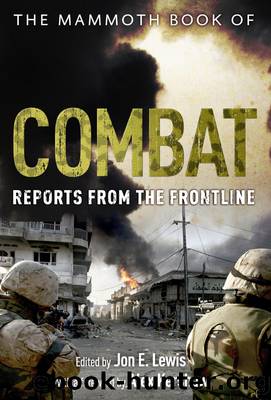The Mammoth Book of Combat by Jon E. Lewis

Author:Jon E. Lewis
Language: eng
Format: epub
ISBN: 9781780339184
Publisher: Little, Brown Book Group
World War II
A.J. LIEBLING
Paddy of the RAF
Joe Liebling covered the Second World War for The New Yorker. As well as a deserving reputation as a war correspondent, he had an entirely separate one as a champion fighter for the underdog. It was Liebling who coined the memorable phrase that âFreedom of the press belongs to the man who owns one.â
New Yorker, 6 December 1941
The few British fighting men who have become popular legends during this war have done so without the connivance of His Majestyâs Government. German and Russian communiqués are studded with the names of individual heroes, but even the RAF, although garrulous compared to the British Army and Navy, believes fliers should be almost anonymous. Whereas the Luftwaffe would announce that the late Werner Mölders had shot down his ninety-ninth plane â and, incidentally, British airmen would take no stock in his score â the Air Ministry says merely that a pilot attached to one of its squadrons scored his eleventh victory. Weeks later, perhaps when the pilot is due for a decoration, his name will appear in the London Gazette, a government newspaper few civilians read. For this reason, a high score is not enough in itself to make a fighter pilot a new personality. He has to have some particularity that the public can remember. Flight Lieutenant Brendan Finucane â Distinguished Service Order and Distinguished Flying Cross with two bars â has established himself in the public mind by being profoundly Irish, so Irish, that strangers spontaneously address him as Paddy, which is also what his friends call him. He is neither Ulster Irish nor Anglo-Irish, nor public-school-and-Oxford denatured Irish but middle-class Dublin Irish, and so proud of it that he has a big shamrock painted on his Spitfire. It is a shamrock designed by the adoring Yorkshire rigger and Canadian fitter who look after his plane. The shamrock has the initials âB.F.â in the center and is surrounded by thorns. The rigger says he knows that thorns belong on a rose, but he feels they are appropriate, and Paddy agrees with him. The same rigger once, after the pilot had shot down his twenty-first plane, thought he would please him by painting twenty-one little swastikas around the periphery of the shamrock. Paddy got angry at this, saying they were an affectation of elegance, and made the rigger remove them. Paddy is twenty-one years and a couple of weeks old, and has a boyish eagerness to avoid any implication of swank. The way he got his most serious war injury fits in almost miraculously with his public personality; he broke his right foot jumping over a wall at a wake.
Being Irish is not itself a rare distinction in the RAF. At least five hundred citizens of Eire wear pilotsâ wings on their tunics and about fifty have been decorated. What made Paddy identifiable even before the public knew his name was his being both Irish and attached to an Australian squadron. When the Londoner at his
Download
This site does not store any files on its server. We only index and link to content provided by other sites. Please contact the content providers to delete copyright contents if any and email us, we'll remove relevant links or contents immediately.
| Publishing & Books | Research |
| Writing |
Autoboyography by Christina Lauren(4691)
Asking the Right Questions: A Guide to Critical Thinking by M. Neil Browne & Stuart M. Keeley(4618)
Dialogue by Robert McKee(3602)
Eat That Frog! by Brian Tracy(3543)
Sticky Fingers by Joe Hagan(3464)
Journeys Out of the Body by Robert Monroe(3013)
Elements of Style 2017 by Richard De A'Morelli(2952)
Annapurna by Maurice Herzog(2856)
Schaum's Quick Guide to Writing Great Short Stories by Margaret Lucke(2818)
Full Circle by Michael Palin(2791)
The Diviners by Libba Bray(2454)
The Art of Dramatic Writing: Its Basis in the Creative Interpretation of Human Motives by Egri Lajos(2425)
The Mental Game of Writing: How to Overcome Obstacles, Stay Creative and Productive, and Free Your Mind for Success by James Scott Bell(2403)
Why I Write by George Orwell(2374)
Atlas Obscura by Joshua Foer(2359)
In Patagonia by Bruce Chatwin(2285)
The Fight by Norman Mailer(2166)
The Elements of Style by William Strunk and E. B. White(2080)
Venice by Jan Morris(2061)
